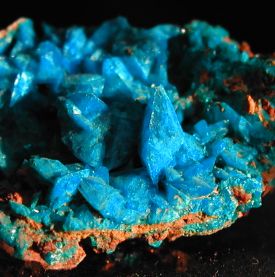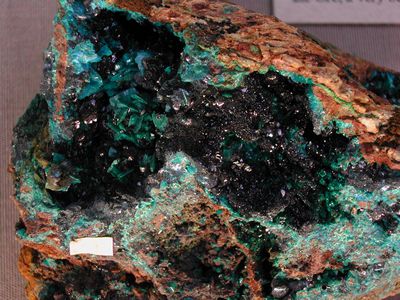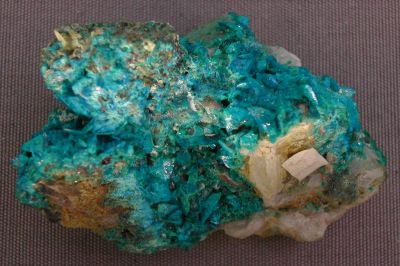 |
 |
 |
 |
|
Liroconite was first discovered in the old copper mines of Cornwall, England in the late 18th century
Liroconite was first discovered around the 1780's and 1790's in Cornwall, and it was illustrated by Phillip Rashliegh in his 'Specimens of British Minerals' in
1797 and 1802. He describes one such specimen of Liroconite on a bed of Olivenite crystals as: "Copper Ore of a Sky blue colour with double four sided pyramids a little transparent and very
perfect, upon needle xtls of Copper Ore of a Grass green colour and opake, upon an ochry Stone of copper ore, r.r.r.r. (exceedingly rare) Huel Mutterel".
In 1801 the Count de Bournon described Liroconite as "Octahedral Arsenate of Copper", naming its discovery site as the area "Gwennap".
Unfortunately he did not name the mine responsible, but it is likely to have been Wheal Muttrell, later to become part of Wheal Gorland.
Wheal Gorland was "so rich at times that the miners have been placed under a strict surveillance lest the Adventurers should be defrauded of the valuable minerals and rich ores" (Francis 1845).
|
|
|
|
 |
|
|
Liroconite - Wheal Gorland, Gwennap, Cornwall, UK
|
|
 |
 |
 |
 |
 |
 |
|
 |
|
|
|
Liroconite and Clinoclase - Wheal Muttrell, Gwennap, Cornwall, UK
"Very dark & light blue Crystals of Copper Ore in the hollow part of a Stone of Quartz" - Rashleigh collection and description.
This specimen is likely to have been found in the late 1700's and shows light blue Liroconite crystals on a bed of dark blue Clinoclase crystals. It can be seen in the
Royal Cornwall Museum in Truro, UK.
|
|
|
|
Liroconite has been given several names
In 1803 Werner named the new mineral "Linsenerz" after the typical elliptical form of the crystals (frequently appearing bent with rounded edges). It was also given
other names such as: Lirokon lirokon-Malachite, Lens copper, and Chalcophasit.
The name now accepted is Liroconite, which comes from the Greek words Liros (meaning pale), and Konia (powder). Literally 'pale powder'. This is
due to the colour of Liroconite when it is in powdered form, which is much paler than the normal bright blue or green colour of the crystals.
|
|
|
|
 |
|
|
Liroconite - Gwennap, Cornwall, UK
|
|

